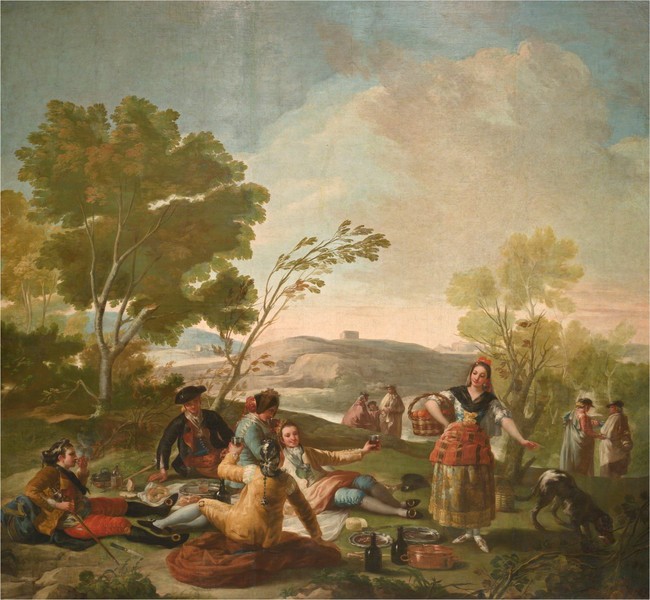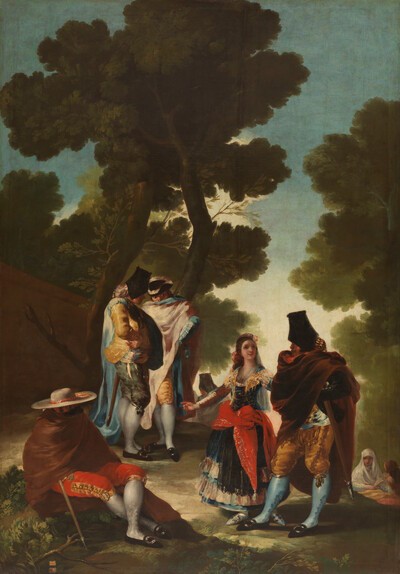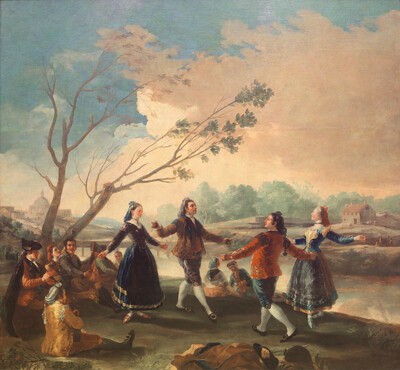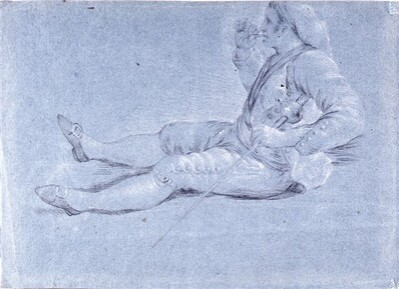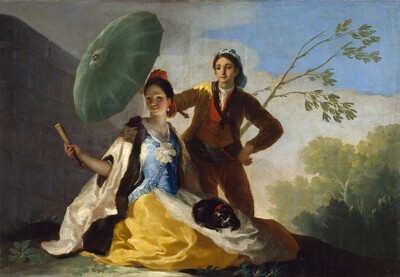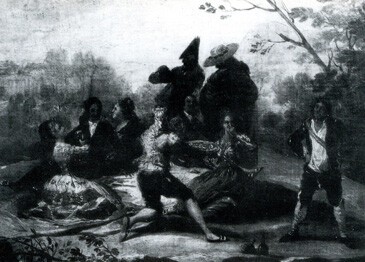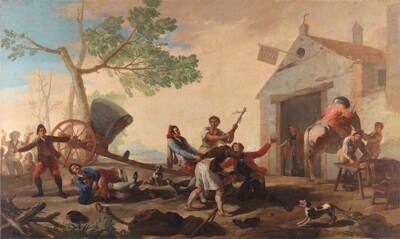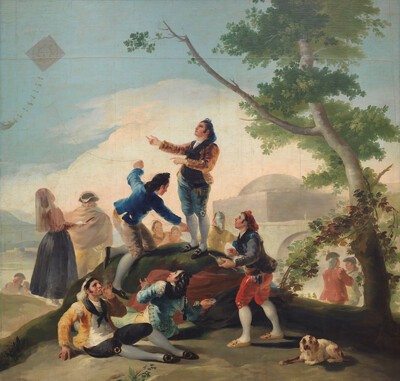- Cronología
- 1776
- Ubicación
- The Prado National Museum. Madrid, Madrid, Spain
- Dimensiones
- 271 x 295 cm
- Técnica y soporte
- Oil on canvas
- Reconocimiento de la autoría de Goya
- Documented work
- Titular
- El Prado National Museum
- Ficha: realización/revisión
- 17 Nov 2009 / 14 Jun 2023
- Inventario
- (P00768)
- Otros títulos:
-
Picnic on the Banks of the Manzanares (La merienda
This work forms part of the series of ten cartoons of country themes for tapestries designed to decorate the dining hall of the Prince and Princess of Asturias in the palace of El Pardo. This one was delivered on 30 October 1776.
Around 1856 or 1857, the cartoon was moved from the Royal Tapestry Factory of Santa Bárbara to the Royal Palace in Madrid. In 1870, it was taken to the Prado Museum under orders given on 18 January and 9 February.
This cartoon is "of my own invention" as Goya himself states in the invoice he delivered to the Royal Factory. He chose the composition, although he still had to take into account the tastes of the tapestry makers and the king, for which reason he always had to complete a preliminary sketch of the work, which would have to be approved before work on the cartoon could go ahead. Furthermore, in some of these cartoons it is still possible to see traces of Goya's doubts and his hesitation about how to resolve certain compositional problems, often leading him to resort to models created by Francisco Bayeu.
"Near the city" is how Goya describes this scene on the banks of the Manzanares river, where the figures are distributed across the different levels of terrain in order to create depth, in the same way as in the cartoon Hunting Party. The main group, forming a circle in the foreground, is made up of five majos (the character of the majismo appears here for the first time in the work of Goya, but in accordance with the demands of the commission rather than by any decision of Goya), and an orange-seller, with whom they are flirting. This is the start of a new genre within the strict court painting, the vitality of its pastoral themes recalling French painting from the same period. Of special interest is the still life in the foreground, around which the majos are positioned. The Hermitage of the Virgin of the Port is just visible in the background, to the right of the centre.
There exist two preparatory drawings showing studies of the majo who is smoking and the other seated majo. There was third, that no longer exists, which showed the three figures on the right of the composition.
-
GoyaPalacio de PedralbesBarcelona1977from April 12th to June 30th 1977
-
Goya. 250 AniversarioMuseo Nacional del PradoMadrid1996consultant editor Juan J. Luna. From March 29th to June 2nd 1996
-
Goya. La imagen de la mujerMuseo Nacional del PradoMadrid2001from October 30th 2001 to February 10th 2002. Exhibitied also at the National Gallery of Art, Washington, March 10th to June 2nd 2002, consultant editor Francisco Calvo Serraller
-
Goya en Madrid. Cartones para tapices 1775-1794Museo Nacional del PradoMadrid2014p. 103
-
Goya: Order and disorderMuseum of Fine ArtsBoston2014cat. 56
-
Tapices de GoyaMadridPatrimonio Nacional1946pp. 52, 63-66, 89, 200, cat. 10 y láms.
-
L'œuvre peint de Goya. 4 volsParís1928-1950vol. I, p. 60, cat. 1
-
Vie et ouvre de Francisco de GoyaParísOffice du livre1970pp. 45, 75, 85, cat. 70 y p. 44 (il.)
-
BarcelonaPolígrafa1970vol. I, pp. 40-41, 245, cat. 62
-
L’opera pittorica completa di GoyaMilanRizzoli1974p. 94, cat. 68
-
Francisco de Goya, 4 vols.ZaragozaCaja de Ahorros de Zaragoza, Aragón y Rioja1980-1982vol. I, pp. 80, 82 y p. 96 (il.)
-
Imagen de GoyaMadridLumen1983pp. 59, 64
-
Francisco de Goya, cartones y tapicescol. col. "Espasa Arte"Espasa Calpe1987pp. 65, 69, 71, 247, cat. 13C y p. 70 (i
-
Francisco de Goya. Los cartones para tapices y los comienzos de su carrera en la corte de Madridcol. col. "Ensayos de Arte Cátedra"MadridCátedra1987pp. 44, 48-55, 59, 61-62, 89 y p. 48 (i
-
Goya. 250 AniversarioMadridMuseo del Prado1996pp. 286-287, cat. 7 y p. 76 (il.)
-
Salas del Palacio Real de El Pardo para las que se tejieron tapices sobre cartones de Francisco de Goya: identificación de las habitaciones y ajuste de las obras de Goya en los alzados de las paredesin HERRERO CARRETERO, Concha (curator, Tapices y cartones de Goya (catalogue of the exhibition organizated at the Palacio Real de Madrid, from may to june 1996)MadridPatrimonio Nacional, Goya 96, Lunwerg1996p. 167 (il.)
-
Goya en Madrid. Cartones para tapices 1775-1794MadridMuseo Nacional del Prado2014p. 103
-
Goya: Order & DisorderBostonMuseum of Fine Arts Boston Publications2014pp. 120-121
